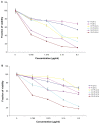Anionic linear-globular dendrimer-cis-platinum (II) conjugates promote cytotoxicity in vitro against different cancer cell lines
- PMID: 20161988
- PMCID: PMC2819903
- DOI: 10.2147/ijn.s8595
Anionic linear-globular dendrimer-cis-platinum (II) conjugates promote cytotoxicity in vitro against different cancer cell lines
Abstract
Due to their unique properties, Anticancer dendrimer-based drugs have been displaying promising results in both in vitro and in vivo in the treatment of cancerous cells, as compared to the traditional polymers. In this report, two conjugates (G1+Pt and G2+Pt) of cisplatin [cis-diaminedichloroplatinum; (CDDP)] with two generations (G1, G2) of a biocompatible anionic dendrimer were prepared in an aqueous media. Their potential cytotoxic effects, in two sensitive cancer cell lines HT1080 and CT26 together with one resistant cancer cell line SKOV3, using MTT (methyl thiazolyl tetrazolium) assay were examined. Hemolytic impacts and cell death mechanisms of the conjugates on human blood and HT1080 cell line were also investigated. The conjugate G2+Pt showed greater toxicity up to 9x and 2x in the sensitive and resistant cell lines (IC(50) comparison, inhibitory concentration) respectively when compared to the parent drug. The G1+Pt conjugate showed greater toxicity only in the sensitive HT1080 (2x) and CT26 (3.7x) cell lines. Moreover, the G1+Pt conjugate was less toxic approximately one third of the cisplatin in SKOV3 after 48 hrs of incubation. In summary, the G2+Pt conjugate had greater toxicity than the G1+Pt conjugate and cisplatin, based on the in vitro results. Approximately the same hemolysis behavior was observed for both conjugates and cisplatin. Both apoptosis and necrosis mechanisms (about 2x more than cisplatin) were attributed to conjugates and cisplatin in a direct correlation between the concentration and the degree of cell death. In conclusion, these conjugates with such high potency and minimum hemolysis would be suitable candidates for use against these cancerous cell lines as efficient and novel antitumor agents.
Keywords: apoptosis-necrosis; cis-platinum (II); dendrimer; hemolysis; in vitro cytotoxicity.
Figures









Similar articles
-
Anionic linear-globular dendrimers: biocompatible hybrid materials with potential uses in nanomedicine.J Mater Sci Mater Med. 2010 Apr;21(4):1121-33. doi: 10.1007/s10856-009-3978-8. Epub 2010 Jan 16. J Mater Sci Mater Med. 2010. PMID: 20082119
-
Evaluation of anionic half generation 3.5-6.5 poly(amidoamine) dendrimers as delivery vehicles for the active component of the anticancer drug cisplatin.J Inorg Biochem. 2011 Sep;105(9):1115-22. doi: 10.1016/j.jinorgbio.2011.05.017. Epub 2011 May 27. J Inorg Biochem. 2011. PMID: 21704583
-
Optimization of carboxylate-terminated poly(amidoamine) dendrimer-mediated cisplatin formulation.Drug Dev Ind Pharm. 2015 Feb;41(2):232-8. doi: 10.3109/03639045.2013.858735. Epub 2013 Nov 18. Drug Dev Ind Pharm. 2015. PMID: 24237325
-
Caffeine citrate enhanced cisplatin antitumor effects in osteosarcoma and fibrosarcoma in vitro and in vivo.BMC Cancer. 2019 Jul 15;19(1):689. doi: 10.1186/s12885-019-5891-y. BMC Cancer. 2019. PMID: 31307409 Free PMC article.
-
[Drug discovery research in in-vivo antitumor-active azolato-bridged dinuclear Pt(II) complexes].Yakugaku Zasshi. 2012;132(3):253-9. doi: 10.1248/yakushi.132.253. Yakugaku Zasshi. 2012. PMID: 22382827 Review. Japanese.
Cited by
-
Gd(3+)-DTPA-DG: novel nanosized dual anticancer and molecular imaging agent.Int J Nanomedicine. 2011;6:747-63. doi: 10.2147/IJN.S17648. Epub 2011 Apr 11. Int J Nanomedicine. 2011. PMID: 21589643 Free PMC article.
-
Novel PH Sensitive Nanocarrier Agents Based on Citric Acid Dendrimers Containing Conjugated β-Cyclodextrins.Adv Pharm Bull. 2011;1(1):40-7. doi: 10.5681/apb.2011.006. Epub 2011 Jul 20. Adv Pharm Bull. 2011. PMID: 24312755 Free PMC article.
-
Induction of Immune Responses by DNA Vaccines Formulated with Dendrimer and Poly (Methyl Methacrylate) (PMMA) Nano-Adjuvants in BALB/c Mice Infected with Leishmania major.Open Access Maced J Med Sci. 2018 Jan 27;6(2):229-236. doi: 10.3889/oamjms.2018.061. eCollection 2018 Feb 15. Open Access Maced J Med Sci. 2018. PMID: 29531579 Free PMC article.
-
Advanced Nanomaterials Functionalized with Metal Complexes for Cancer Therapy: From Drug Loading to Targeted Cellular Response.Pharmaceuticals (Basel). 2025 Jul 3;18(7):999. doi: 10.3390/ph18070999. Pharmaceuticals (Basel). 2025. PMID: 40732288 Free PMC article. Review.
-
Synthesis of New Functionalized Citric Acid-based Dendrimers as Nanocarrier Agents for Drug Delivery.Bioimpacts. 2011;1(1):63-9. doi: 10.5681/bi.2011.009. Epub 2011 Jun 9. Bioimpacts. 2011. PMID: 23678409 Free PMC article.
References
-
- Ringsdrorf H. Structure and properties of pharmacologically active polymers. J Polym Sci Polymer Symp. 1975;51:135–153.
-
- Caiolfa VR, Zamai M, Fiorini A, et al. Polymer-bound camptothecin: initial biodistribution and antitumor activity studies. J Control Release. 2000;65:105–119. - PubMed
-
- Malik N, Evagorou EG, Duncan R. Dendrimer-Platinate: a novel approach to cancer chemotherapy. Anti-cancer Drugs. 1999;10(8):767–776. - PubMed
-
- Roy R. Recent developments in the rational design of multivalent glycoconjugates. Top Curr Chem. 1997;187:241–274.
-
- Duncan R, Izzo L. Dendrimer biocompatibility and toxicity. Adv Drug Del Rev. 2005;57:2215–2237. - PubMed
Publication types
MeSH terms
Substances
LinkOut - more resources
Full Text Sources

